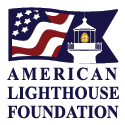
Keeper Joshua Card served at Portsmouth Harbor Light from 1874 to 1909.
(Portsmouth Athenaeum photo)
Lighthouse enthusiasts are quite familiar with the responsibilities of bygone lightkeepers. First and foremost, keepers were expected to maintain a good light each and every night, and during periods of poor visibility, ensure the fog signal was sounding its audible warning. Of course, maintaining the light station buildings in good condition was also a big part of the job.
However, rarely was a keeper asked to carry out additional responsibilities that extended beyond the care of the light station. One such instance occurred at Portsmouth Harbor Light (also known as Fort Point Light) in 1889 for an unspecified period of time when keeper Joshua Card was directed to place a light on the mast of a shipwreck each day at sundown until the vessel was removed from the shipping channel. The wreck was posing a navigational hazard to marine traffic due to its location.
So not only did Keeper Card have to ensure the light in Portsmouth Harbor was shining bright – and keep the fog signal sounding if warranted, he also had to row over to the wreck regardless of weather and seas to light / mark the location of the schooner for a short period of time.
The following account appeared in The Portland Daily Press, August 9, 1889.

An 1880s view of Portsmouth Harbor Lighthouse and Fort Constitution.
(Portsmouth Athenaeum photo)
“Portsmouth, N.H., August 8. – Col. W. H. Sise, chairman of the Portsmouth board of pilot commissioner, has been in communication with Commander Wildes, lighthouse inspector district, in regard to the wreck of the schooner George Savage, which lies east of Fort Constitution, nearly in mid-channel, and in the direct track of navigation; and, as a result of the correspondence, the inspector has ordered the keeper of Fort Point Light to hang a white light on the masthead of the wreck, which projects some twenty feet out of water, at sunset each evening until the removal of the wreck.”

A vintage postcard view of Portsmouth Harbor Light.
(Jeremy D’Entremont collection)

